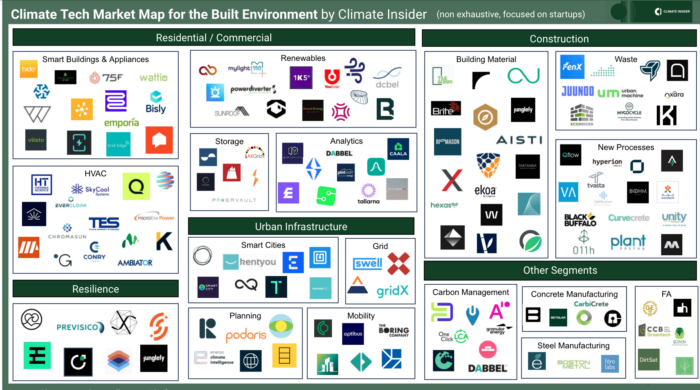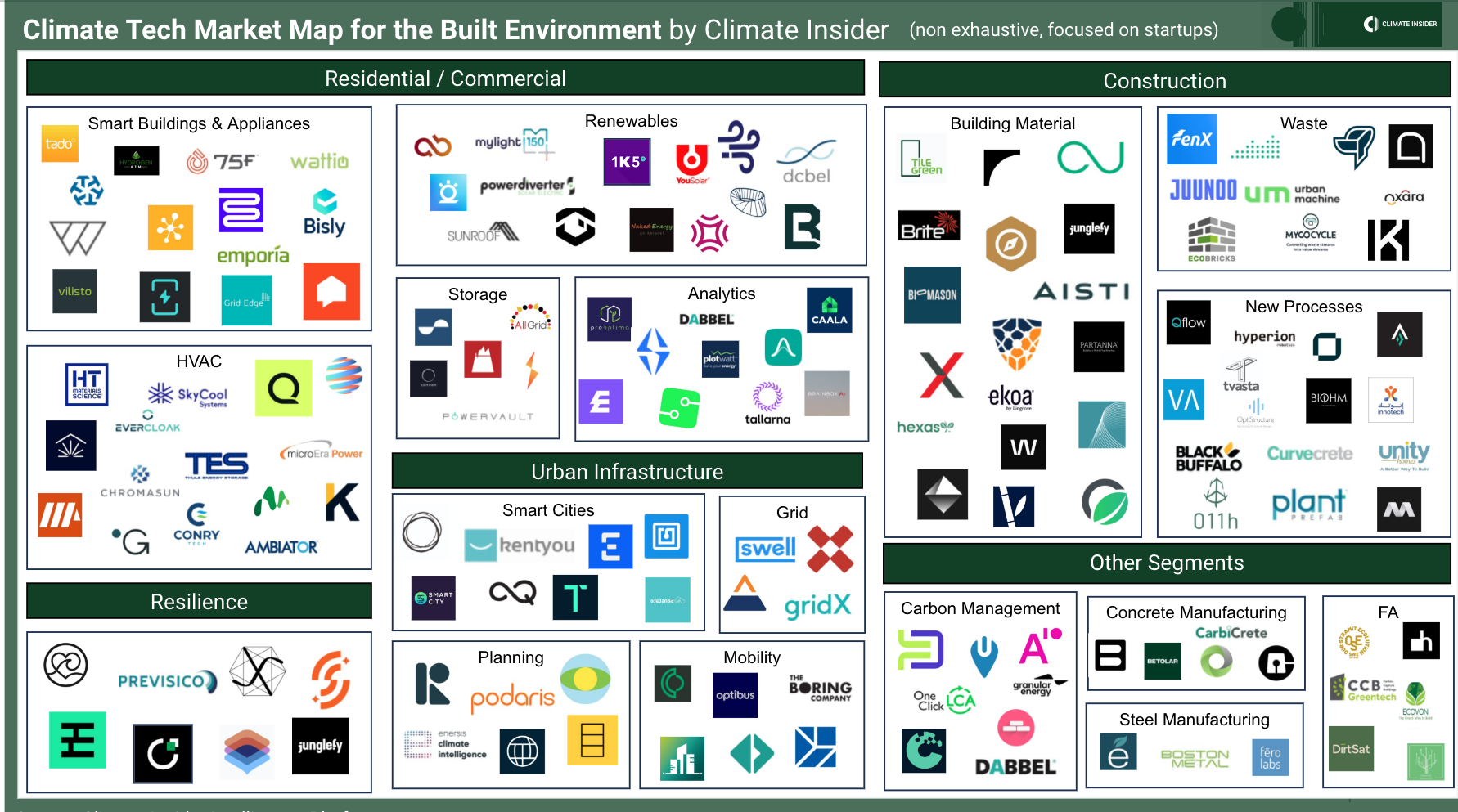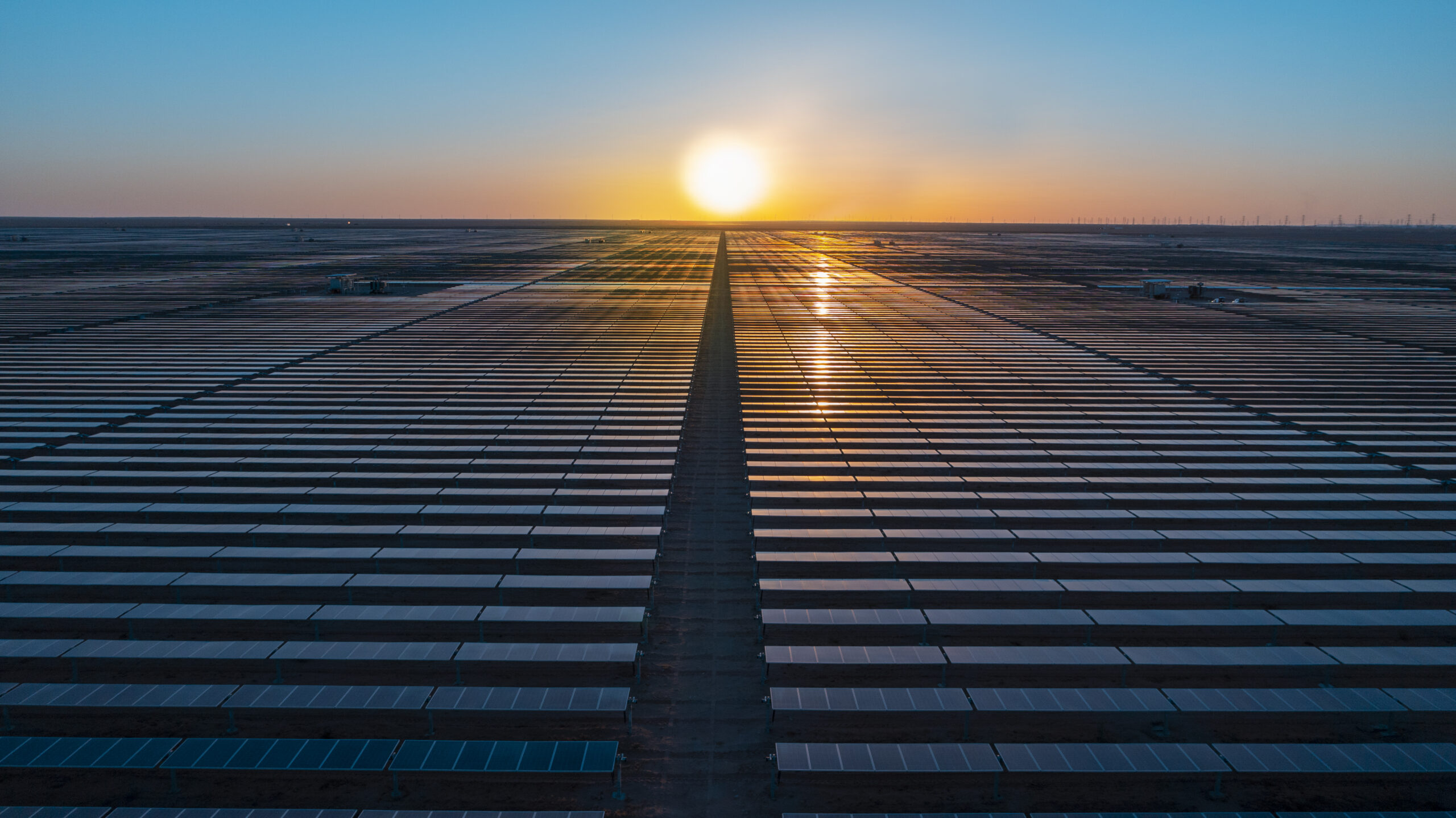Author: Dwayne Pattison
Next in our series of market maps focuses on the companies in the Built Environment. The built environment, encompassing residential, commercial, and urban infrastructure, significantly impacts climate change. It is responsible for a substantial portion of global energy consumption and greenhouse gas (GHG) emissions.
We also include construction on the map. The construction industry plays a pivotal role in addressing climate change. And it is not just about building new structures, but also about how they are made, the materials used, and their long-term environmental impact. Innovative climate technologies in construction are essential for reducing GHGs and promoting sustainability.
Startups and Innovation in Climate Technology
Startups are at the forefront of innovation in climate technology for the built environment. They are working in the following areas:
- Advanced Materials: Startups are creating new, sustainable building materials that reduce the environmental impact of construction.
- IoT and AI Integration: Many startups are integrating AI and IoT to create smarter, more efficient building management systems.
- Renewable Energy Solutions: Innovative approaches to solar, wind, and geothermal energy are being developed for buildings, making renewable energy more accessible and efficient.
- Climate Resilience and Adaptation: Companies are developing technologies that help buildings and cities minimise the effects of climate change, like sea-level rise and extreme weather events.
Key Segments
Like the maps and taxonomies that came before, it is challenging to decide how best to divide the companies into segments so that it creates a better understanding of the market. We consider this our first iteration and will continue to assess to see if the way we have organised the companies still makes sense in the next instalment. Under each segment, we have included the following sub-segments:

Residential and Commercial
- Smart Buildings & Appliances
- Heating, Ventilation and Air Conditioning (HVAC)
- Renewables
- Storage
- Analytics
Construction
- Building Material
- Waste
- New Processes
Urban Infrastructure
- Smart Cities
- Grids
- Planning
- Mobility
Other Segments (highlighted in other market maps and taxonomies from the Climate Insider)
- Resilience and Adaptation
- Carbon Management
- Manufacturing (specifically for concrete and steel)
- Food and Agriculture (FA)
Check out the map below. We have packed in 156 companies on there, which are just as diverse and innovative as the companies we have included on the previous market maps.

Residential and Commercial Climate Technologies
Although startups and climate tech companies tend to focus on either residential or commercial buildings, the goals and technologies involved are shared among the two sectors. These technologies include:
- Smart Home and Smart Building Technologies: Companies employing IoT devices for monitoring and optimizing energy use (e.g. smart meters and energy management systems) cloud analytics and software as a service (SaaS)-based platforms are highlighted. We also include companies working on energy-efficient appliances and systems such as smart thermostats, smart home appliances and LED lighting, which are becoming standard in modern homes.
- Heating, Ventilation and Cooling (HVAC) systems: Advanced, energy efficient systems that optimize energy use in homes or commercial buildings.
- Heat pumps in particular have emerged a key technology of interest. They can provide heating, cooling, and hot water at significantly lower energy costs.
- Retrofits: Acknowledging the vast number of existing buildings with outdated HVAC systems, startups are offering retrofitting solutions that improve the efficiency of these systems.
- Geothermal Heating and Cooling: These HVAC systems offer an efficient solution for heating and cooling.
- Renewable Energy Solutions: Residential solar installations enable homeowners to generate their own clean energy. Additionally, more work is being done on urban wind power and geothermal energy.
- Energy Storage: As more buildings adopt renewable energy, there need to be effective ways of storing intermittent energy on site, as is the case with utility-scale grids. Key technology improvements are ongoing on lithium ion batteries, solid-state batteries and flow batteries.
- Analytics: Data analytics is a powerful tool in optimizing the built environment for climate goals. Key technologies being developed are:
- Predictive Analytics for Energy Management: Using historical data to forecast energy needs and optimize usage accordingly.
- AI for Fault Detection and Maintenance: Identifying issues before they become significant problems, thereby saving energy and reducing costs.
- Sustainability Reporting Software: Tools that help buildings monitor their carbon footprint and progress towards sustainability goals.
Urban and City-Scale Technologies for the Built Environment
In the face of rapid urbanization and climate change, cities around the world are at the forefront of adopting innovative solutions to create sustainable, livable urban environments. Some of the initiatives related to the built environment include:
- Smart Cities: Companies working on technologies for smart cities take a systems approach to apply the technologies we see for smart buildings. They use IoT, machine learning, analytics, new materials and products. Various components of a smart city can also include waste reduction technologies such as composting, recycling, and waste-to-energy systems or smart grids and transportation, as discussed below.
- Urban Planning: Eco-friendly urban design that promotes public transportation, cycling, and pedestrian pathways.
- Smart Grids: Advanced energy grids that integrate renewable energy sources and improve energy distribution efficiency.
- Mobility: The focus for this segment is public transportation infrastructure, such as electric buses, light rail systems, and other low-emission public transport options. Each option requires supporting infrastructure, such as roadways, pathways and tracks, to operate effectively. We didn’t include those companies working on EV infrastructure as they were highlighted in our market map on Energy.
For all of these initiatives, enabling technologies such as digital twins, smart sensors, and cloud computing, to name a few, are important in understanding opportunities and challenges of developing large-scale infrastructure projects within the urban landscape.
Key Climate Technologies in Construction
The construction industry is also developing or adopting technologies that can reduce or eliminate carbon emissions. Key initiatives include:
Building Materials
- Recycled Materials: Using recycled steel, glass, and plastic reduces waste and energy consumption.
- Low-Carbon Concrete: Alternatives to traditional cement, such as those using fly ash or slag, significantly reduce CO2 emissions.
- Green Building Materials: Sustainable materials like bamboo, recycled steel, and green insulation that have a lower environmental impact are increasinlgy being integrated into construction projects. Startups are focusing on producing low-carbon insulation materials.
New Construction Practices
- Modular Construction: Pre-fabricated modules built off-site may lead to less waste and reduced energy use.
- 3D Printing in Construction: Reducing material waste and energy use through precision.
- Enabling technologies: Companies are developing smart sensors and systems for real-time energy monitoring and optimization. Startups are also leveraging AI and machine learning for efficient project management and reduced resource use.
Waste Management
- Material Recycling: Many startups focus on recycling construction materials, from concrete to metals, turning them into new building materials
- Efficient Water Use: Reducing water waste during the construction process.
- Marketplaces for Leftover Materials: Online platforms and apps connect construction projects with excess materials to other projects where they can be used.
- Circular Economy Approaches: Startups are creating business models that encourage the reuse and recycling of materials throughout the construction industry.
- AI and Machine Learning: Some startups use AI to analyze project data, improving material procurement and inventory management, ensuring materials are ordered and used efficiently to minimize surplus and waste.
Resilience
As mentioned in our first Climate Tech Market Map, we give attention to how companies are developing technologies that allow for people to better adapt to changing climate conditions and the associated extreme weather events such as drought, flooding, high winds, and heat and cold waves.
We will release our climate resilience and adaptation market map in the upcoming weeks, but it is necessary to include a section here in Built Environment, given the importance of having resilient buildings and homes during these events.
More and more companies are starting to think about building architecture and urban design that can better prepare for a changing climate. For example, some companies are developing designs that are more resilient to high winds and flooding. The HVAC equipment described above is also essential during prolonged heat waves that can be exacerbated by the urban environment due to a high concentration of asphalt and buildings and lack of vegetation.
Other Key Segments
The climate technologies for the built environment meld into other segments we have discussed as part of our market map series (See Food & Agriculture, Energy and Transportation). Cities and communities, for example, are a key partner in the development of mobility infrastructure including charging stations and the planning around micromobility. Other relevant segments include:
- Manufacturing: We delve further into the new production processes for steel and concrete in our Industry Market Map (upcoming). These two sectors account for a large portion of the emissions from construction materials.
-
- Concrete and Steel Manufacturing Processes: Above, we include startups working on eliminating concrete and finding alternative inputs. Here startups are looking at new ways of manufacturing concrete or steel to lower these inputs’ environmental footprint.
- Food and Agriculture: This segment has two primary categories:
- F&A Infrastructure: For modern agriculture, energy efficient structures are essential. Developing indoor food production systems (e.g. hydroponics and aquaponics, greenhouses) that are energy efficient can lower emissions in these types of buildings.
- Building Materials: Some of the companies on our map are also using biotech and agricultural waste to develop new building materials.
- Carbon Management: We will be developing a market map on carbon management in the coming weeks. In this map, we include companies that are working on products or services that are focused on the built environment whether they are helping lower the emission of a house or building or for larger urban systems within a city or community.
The integration of climate technology in the built environment is a critical step towards a sustainable future. From individual homes to entire cities, these technologies not only reduce the environmental impact but also pave the way for a healthier, more resilient world.
To stay informed about the climate industry explore our latest climate tech news.
Companies on the Map
011h
1Komma5
75F
Absolar
Accelerate Wind
Adaptis
Advanced Autoponics
African Bamboo
Aisti
All Grid Energy
AMBIATOR
AMP
Ampd
Arkeon Energy Systems
Arqlite
Audette
Axle Energy
Banqloop
Bedrock Energy
Betolar
Biohm
BioMason Bio-Bricks
BioZeroc
Biozeroc
Bisly
Black Buffalo 3D
Bloc Power
Boring COmpany
Boston Metal
Brainbox
Brite Solar
CAALA
Candam Tech
CarbiCrete
Carbon Crusher
CCB Greentech
Cercula
Chromasun
Climate Alpha
ClimateView
concrete.ai
Conry Tech
Curvecrete
Dabbel
Dabbel
Dandelion Energy
dcbel
DirtSat
Ecobricks
ecoLocked
Ecovon
Ecoworks
EHAB
electra
Electriq Power
Emporia
EnergyHub
enersis suisse AG
Ento
Evercloak
Everimpact
FenX
Fero Labs
Fuergy
Geneverse Energy
Gradient Comfort
Granular Energy
GraphenePioneer
Grid Edge
gridX
GRT
Hempitecture
Hexas Biomass
HT Materials Science
Hydrogen ATM
Hyperion Robotics
Infrared City
Innotech
Inspire
Junglefy
Juunoo
Kelvin
Kentyou
Kind Designs
Lasso Loop
Lingrove
LiveEO
Lunar Energy
MAGNOTHERM
Metiundo
MicroEra Power
Mighty Buildings
Mixteresting
Moduly
Mortar IO
Mycocycle
Mylight150
Naked Energy
Nanotech
Nexii
Nostromo
One Click Lca
Optibus
OptiStructure
Our Ecolution
Oxara
Partanna
Partanna Global
Plant PRefab
Plot Watt
Podaris
Populus
Powerdiverter
Powervault
Preoptima
Previsico
Qualis Flow
Quatt
Rematter
Remix
Route Konnect
Sadeem
Sense
Senstate
Sidewalk Labs
Sistine Solar
SkyCool Systems
Smart City
Sobolt
Solenica
Sonnen
Structure Pal
Sublime Systems
SunRoof
Swell Energy
tado
Tallarna
Telensa
Thule Energy Storage
TileGreen
Triple Solar
Turntide
Tvasta
Unity Homes
Urban Footprint
Urban Machine
Urban SDK
Urbanteo
Urbio
Vantem Global
Vilisto
Virtual Peaker
Wattio
Wondrwall
Woodoo
YouSolar








